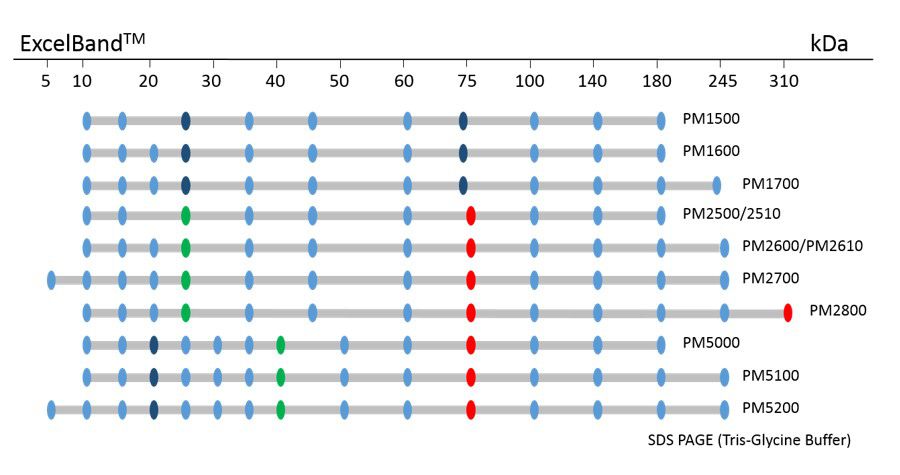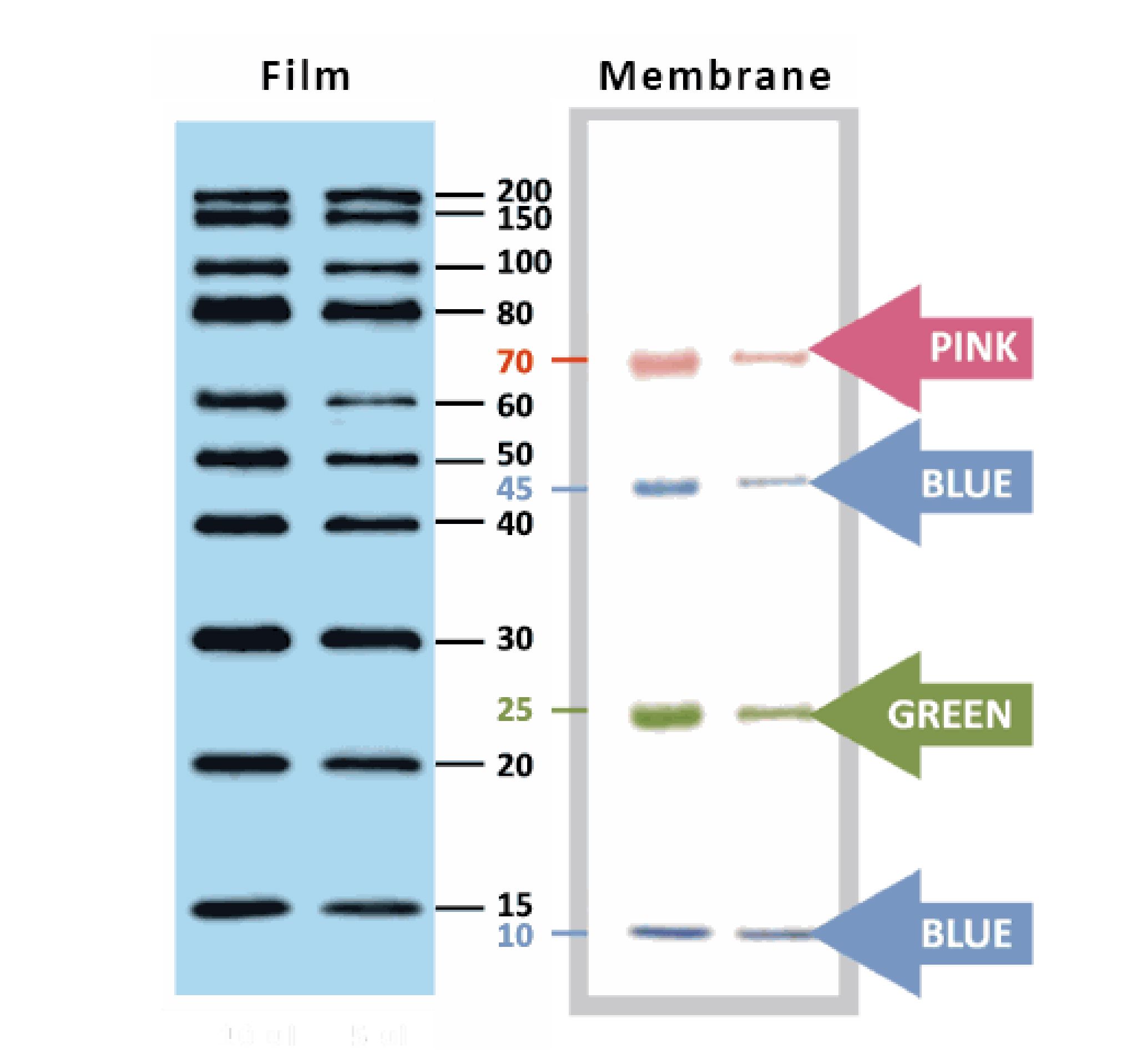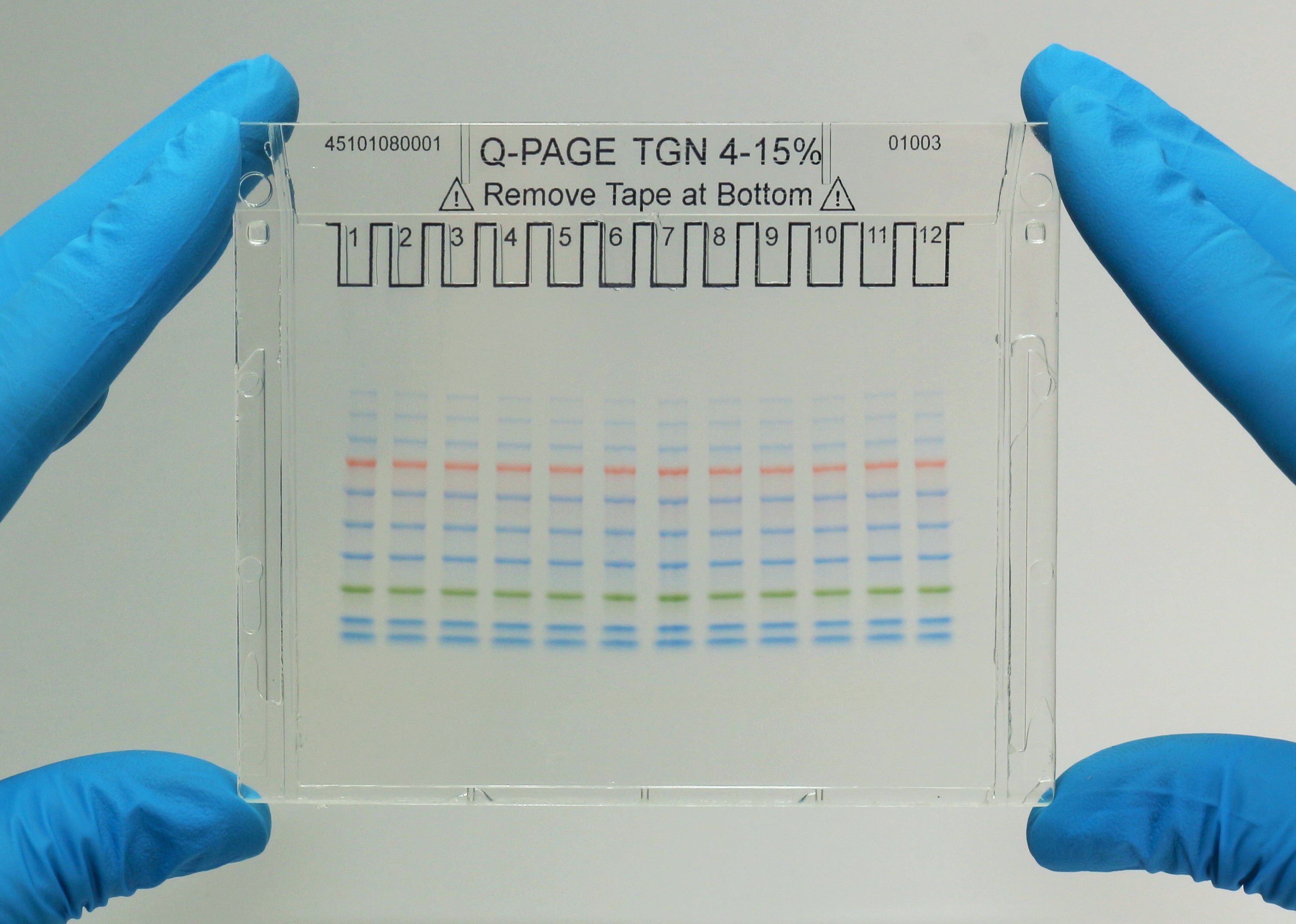Description
The PM6628 ProMetric™ TriColor Low Range Protein Ladder, 2 to 40 kDa, is a ready-to-use three-color protein standard with 6 pre-stained proteins covering a range of molecular weights from 2 to 40 kDa. Proteins are covalently coupled with a blue chromophore except for two reference bands (one green and one red band at 10 kDa and 40 kDa respectively) when separated on SDS-PAGE. The PM6628 ProMetric™ TriColor Low Range Protein Ladder is designed for monitoring protein separation during SDS-PAGE electrophoresis, verification of Western transfer efficiency on membranes (PVDF or nitrocellulose) and for approximating the molecular weight of small proteins.
Features
• Ready-to-use — Premixed with a loading buffer for direct loading, no need to boil
• Two reference bands — 40 kDa (red) and 10 kDa (green)
• Enhanced band clarity for proteins below 10 kDa
• Versatile application across various gel systems, including Tris-Tricine, Tris-Glycine, and Bis-Tris gels
Storage Buffer
20 mM Tris-phosphate (pH 7.5 at 25°C), 1% SDS, 6 M Urea, and 20% (v/v) DMSO.
Quality Control
Under suggested conditions, PM6628 ProMetric™ TriColor Low Range Protein Ladder, 2 to 40 kDa, resolves 6 major bands in SDS-PAGE (Tris-tricine-SDS Buffer).
Storage
4°C for 3 months
-20°C for long term storage
Specification
Cat. No. | PM6628 |
Series Name | ProMetric™ |
Product Size | 250 μl |
MW Range | 2 – 40 kDa |
Band Number 6 | 6 |
Band Color | Red/Green/Blue |
Markered Bands | 10, 40 kDa |
Manual
Manual_PM6628_ProMetric™ TriColor Low Range Protein Ladder (2024 ver. 1.1.0)
SDS
Migration patterns and approximate MWs (kDa).
Tips for usage
1.Optimal gel conditions for PM6628:
For optimal results with the PM6628, we recommend using a 37.5:1 or 29:1 acrylamide-to-bisacrylamide ratio for Tris-Tricine gels.
Avoid the 19:1 ratio due to its variability in formulation, potential use of hazardous chemicals, and longer electrophoresis times, particularly with 18% Tricine gels.
Using Tris-Tricine gels with concentrations in the range of 14% to 16% is generally sufficient to achieve good separation of the PM6628.
2.Tips for separating low MW proteins (e.g., < 10 kDa) using Tris-Glycine gels:
Opt for a 15% acrylamide gel: In Tris-Glycine gel electrophoresis, a 15% acrylamide gel is generally effective for separating small proteins in the 2 to 10 kDa range.
Using higher acrylamide concentrations: Gels with acrylamide concentrations higher than 15% may show decreased resolution for small proteins due to challenges in gel preparation, such as uneven polymerization and bubble formation. If using a higher acrylamide gel is necessary, consider the following tips:
a. Keep stacking gel layer thin: Limit the stacking gel layer to less than 5 mm (from the well bottom to the top of the separation layer) to ensure proper stacking and avoid ambiguous results.
b. Adjust electrophoresis setting: For better stacking of small proteins, try running the electrophoresis at 100V for 15 minutes followed by 150V for 60 minutes.
c. Use a loading tip: Employ a gel loading tip to accurately load samples and protein markers near the well bottom, which helps to improve stacking and separation of very small proteins.
3.Tips for Western Blotting of low molecular weight proteins:
Choose appropriate membrane:
Use membranes with smaller pore sizes (e.g., 0.2 μm) for better transfer of small proteins. Thicker PVDF membranes enhance binding and stability. Consider using NC membranes, if your target proteins or peptides are prone to be lost on PVDF.
Optimize transfer buffer:
Avoid adding SDS to the transfer buffer as it impairs protein binding. Increase methanol concentration up to 25% for better membrane binding. Alternatively, using ethanol can also enhance binding for small proteins.
Post-transfer procedure:
Rinse the membrane with distilled water immediately after transfer. Proceed with blocking, washing, and incubation at 4°C. If further immobilization of small peptides on membrane is needed, dry the membrane at room temperature before blocking. Limit Tween-20 to no more than 0.1% in washing and blocking buffers.
Why are there contrasting results in molecular weights after using different brands of protein markers?
A. Protein composition: The molecular weight discrepancies observed after using different brands of protein markers can be attributed to variations in protein composition and how these proteins interact with SDS. Small proteins and peptides, despite having similar molecular weights, can display differing migration patterns in SDS-PAGE due to differences in their amino acid composition and structure.
For example, factors such as charge, hydrophobicity, and the presence of post-translational modifications can influence how these proteins bind to SDS. As a result, the protein with same molecular weight may migrate differently in gels when different protein markers are used, reflecting the unique formulations and compositions of those markers.
While protein markers are essential for estimating molecular weights, they do not provide absolute standards, particularly for smaller proteins or peptides where such variations can significantly affect migration behavior.
B. Experimental conditions: Several factors during SDS-PAGE can impact protein mobility, including the composition of the running buffer, gel percentage, voltage applied, running time, and whether a pre-run was conducted. These variables can lead to differences in migration patterns and apparent molecular weights among different brands of protein markers.
How many times of freezing and thawing are available for protein markers? If it uses 5 μL per load, would the total usage quantity be 50 times (250 μL)?
Yes, 50 uses (5 μL each time) can be expected if freezing and thawing are conducted carefully and properly at the appropriate temperature.
Before each use, make sure the protein marker is thoroughly thawed.
Do you have data comparison for protein molecular weight’s precision with other protein markers?
Yes. Typically, pre-stained markers are written on “estimated molecular weight” for caution. It is known that the analysis of protein size by an SDS-PAGE is only for “estimation” because of the intrinsic variation of amino acid composition in all proteins including stained and non-stained ones.
For example, a protein which is highly hydrophilic might show a particular higher position in the SDS-PAGE analysis when compared to a hydrophobic one. We did compare the migration patterns of SMOBIO’s Protein Markers with other brands, and we concluded that it was difficult to define “precision” due to the reasons mentioned above.
Therefore, in the product description, we suggest our users to calibrate the MW against their interested proteins. Although it is difficult to define "precision" for molecular weight of proteins in SDS-PAGE, we did compare the migration pattern of pre-stained markers with unstained protein marker (Invitrogen MARK12) for calibration. Additionally, low molecular weight proteins may be affected by variables such as gel type and electrophoresis conditions, which can lead to discrepancies when compared to markers from other brands.
Will SMOBIO’s PM6628 Protein Ladder be affected by the stripping/deprobing process?
Under normal circumstances, the stripping/deprobing process will have minimal impact on SMOBIO’s Protein Markers/Ladders. However, it’s important to note that the intrinsic properties of small molecules, particularly small target peptides, make them more susceptible to loss during this process. Therefore, it is advisable to avoid stripping whenever possible or to minimize the extent of stripping.
To further reduce any potential effects, avoid excessive washing and refrain from washing at room temperature. Proper control of washes prior to stripping can significantly lessen the impact, but the presence of Tween-20 on the membrane during this process can still adversely affect the performance of SMOBIO’s Protein Markers/Ladders.
What type of gel should I use for resolving low molecular weight (MW) proteins (e.g., < 30 kDa)?
For proteins below 30 kDa, a Tricine gel is recommended. It is specifically designed to improve resolution for proteins under 20 kDa, providing better separation and sharper bands for low MW proteins.
What is the recommended acrylamide-to-bisacrylamide ratio for Tricine gels when using PM6628?
We recommend using a 37.5:1 or 29:1 acrylamide-to-bisacrylamide ratio for optimal performance with PM6628 in Tricine gels
Can I use a 19:1 acrylamide-to-bisacrylamide ratio for Tricine gels when using PM6628?
The 19:1 ratio is not recommended due to potential formulation inconsistencies, the possible use of hazardous chemicals, and longer electrophoresis times, particularly when using 18% Tricine gels.
Are low MW proteins more susceptible to "over-transfer" or “blow through”?
Low MW proteins, typically those below 15 kDa, are prone to "over-transfer," meaning they can be lost during the transfer process. This occurs due to inadequate retention by the membrane and the potential for too-rapid transfer, which can lead to incomplete transfer or loss of the protein from the membrane.
How can I optimize the protein transfer process for low MW proteins?
To optimize transfer for low MW proteins, consider the following strategies:
• Choose appropriate membrane:
Use membranes with smaller pore sizes (e.g., 0.2 μm) to enhance the transfer efficiency of small proteins. Thicker PVDF membranes can improve protein binding and stability. If your target peptides are prone to loss on PVDF, consider using nitrocellulose (NC) membranes, which may provide better retention for low MW proteins.
• Optimize transfer buffer:
For blotting Tricine gels, we recommend using 1× Tris-Glycine Transfer Buffer with 20% methanol. Avoid adding SDS to the transfer buffer, as it can impair protein binding to the membrane. Increasing the methanol concentration in the buffer up to 25% can improve protein binding efficiency. Alternatively, using ethanol instead of methanol can also enhance binding for small proteins.
What can I do to improve the detection of low MW proteins after transfer?
Rinse the membrane with distilled water immediately after the transfer. Then, proceed with blocking, washing, and incubation at 4°C. If additional immobilization of small peptides on the membrane is required, dry the membrane at room temperature before starting the blocking step. Ensure that Tween-20 is kept at a concentration of 0.1% or less in both the washing and blocking buffers.
What happens if a Tricine gel is accidentally run with Tris-Glycine buffers?
If a Tricine gel is run with Tris-Glycine running buffer, the gel will take longer to run and provide poorer resolution, particularly for smaller proteins. This is attributed to a combination of the increased stack area size (as glycine is a slower ion compared to tricine) and the higher ionic strength of the Tricine gel.
Do you have recommended staining procedures for Tricine gels?
To stain proteins in the Tricine gels with Coomassie dye:
A. Wash the gel with 100 mL of ultrapure water for 1 minute with gentle agitation and discard the wash.
B. Stain the gel with 0.1% Coomassie dye dissolved in 40% ethanol and 10% acetic acid for 20-30 minutes with gentle agitation.
C. Destain the gel in destaining solution Ⅰ (40% ethanol and 10% acetic acid). Incubate with gentle agitation on a rocker for 60 minutes.
D. Discard the solution.
E. Continue destaining with destaining solution Ⅱ (9.5% ethanol and 7% acetic acid) until bands are very clean. Usually we destain the gel overnight in destaining solution Ⅱ with several Kimwipes present.
F. Transfer the gel to water.
To be update

ExcelBand™ Protein Markers
Ready-to-use— premixed with a loading buffer for direct loading, no need to boil
Broad range— 310 kDa to 5 kDa
Pre-stained bands — for monitoring protein separation during electrophoresis and Western blotting transferring efficiency on membrane
Enhanced bands— for quick reference

YesBlot™ Western Marker I
Ready-to-use — no need of mixing or heating before sample loading
Direct visualization — 10 IgG-binding proteins for direct visualization on Western blots
Pre-stained bands — 4 pre-stained proteins for monitoring protein separation during electrophoresis and Western blotting transferring efficiency on membrane
Wide range — 10 clear bands from 15 to 200 kDa for size estimation
Quick reference — two enhanced bands (30 and 80 kDa)

Q-PAGE™ Precast Gels
User-friendly gel cassette:
Numbered and framed wells for sample loading
Labeled warning sign and green tape as reminder
Enhanced gel performance:
Enhanced gel electrophoresis speed
Better band separation
Stable for shipping at ambient temperature
Easy compatibility:
Available as homogeneous and adjusted gradient gels for a wide range of protein separation.
Compatible with most popular protein electrophoresis systems

![[PM6628] ProMetric™三彩低範圍蛋白質分子量標記, 2 to 40 kDa, 250 μl](/web/image/product.template/482/image?unique=c1dcf72)
![[PM6628] ProMetric™三彩低範圍蛋白質分子量標記, 2 to 40 kDa, 250 μl](/web/image/product.image/299/image?unique=de09cc1)
![[PM6628] ProMetric™三彩低範圍蛋白質分子量標記, 2 to 40 kDa, 250 μl](/web/image/product.image/300/image?unique=de09cc1)
![[PM6628] ProMetric™三彩低範圍蛋白質分子量標記, 2 to 40 kDa, 250 μl](/web/image/product.image/301/image?unique=de09cc1)
![[PM6628] ProMetric™三彩低範圍蛋白質分子量標記, 2 to 40 kDa, 250 μl](/web/image/product.image/302/image?unique=de09cc1)
![[PM6628] ProMetric™三彩低範圍蛋白質分子量標記, 2 to 40 kDa, 250 μl](/website/image/product.template/482/image/90x90)
![[PM6628] ProMetric™三彩低範圍蛋白質分子量標記, 2 to 40 kDa, 250 μl](/website/image/product.image/299/image/90x90)
![[PM6628] ProMetric™三彩低範圍蛋白質分子量標記, 2 to 40 kDa, 250 μl](/website/image/product.image/300/image/90x90)
![[PM6628] ProMetric™三彩低範圍蛋白質分子量標記, 2 to 40 kDa, 250 μl](/website/image/product.image/301/image/90x90)
![[PM6628] ProMetric™三彩低範圍蛋白質分子量標記, 2 to 40 kDa, 250 μl](/website/image/product.image/302/image/90x90)